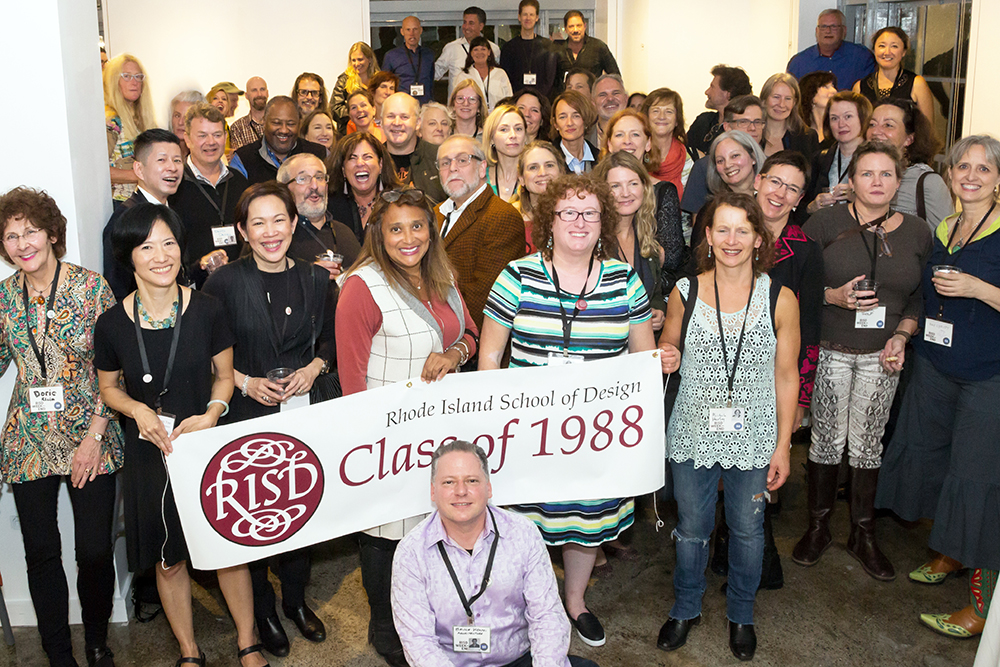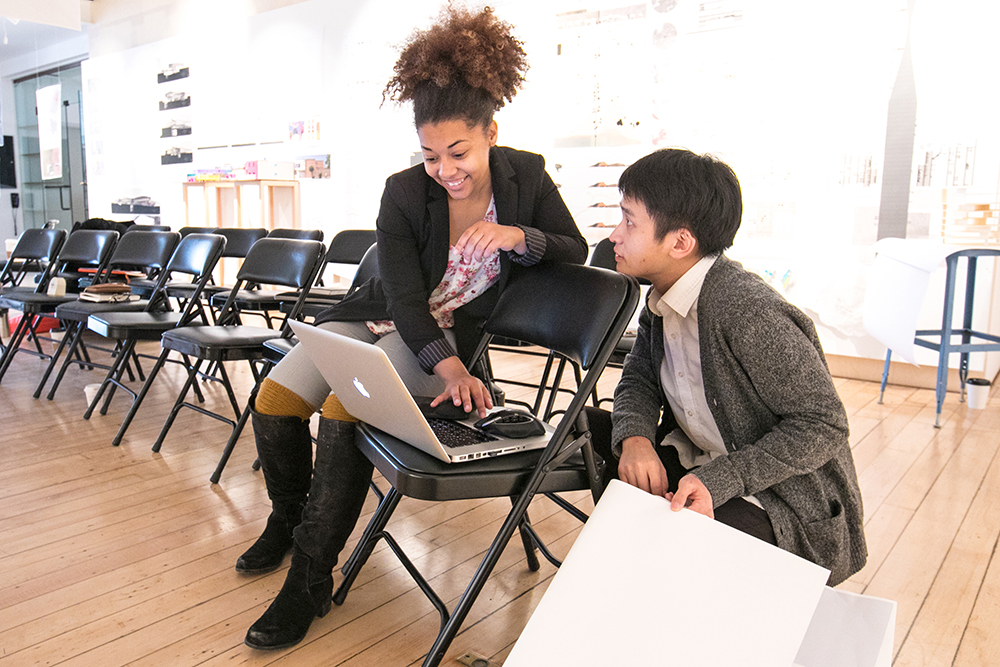
State of Flux
Ilana Savdie’s paintings—currently on exhibit at the Whitney—dazzle, beguile and refuse to stay put.
MARIMONDA IS PART MONKEY, part elephant, the sly trickster of folklore that crowds come out to see at Colombia’s largest carnival, a music and dance festival that takes over the Caribbean coastal city of Barranquilla for four days every year leading up to Lent.
Marimonda also flits in and out of the most recent series of paintings by Ilana Savdie 08 IL, on view in Radical Contractions through November 5 at the Whitney Museum of American Art. We see the mischievous spirit in tantalizing glimpses, a mask here, a hand there, promising to resolve into a figure, but just as quickly dissolving or shifting into another shape altogether. Like much about Savdie’s work, Marimonda refuses to stay put.
By turns seductive and nightmarish, Savdie’s paintings dazzle the eye with luminous, tropical shades of lime and magenta, flesh pink and cobalt. Expanses of thick brushwork butt up against fluid swaths of gauzy pigment. Sections of hard-edged detail meticulously painted in oil border fields of wrinkly, raw beeswax. Abstract forms rooted in the physical body—tissue, tendons, bones and organs—combine, intertwine and melt into one another, never quite coalescing into a legible narrative. Parasitic forms coil and twist, bulge and constrict. We feel a twinge of revulsion but we can’t stop looking.
“I get a lot of pleasure in the fusing together of disparate parts and colliding of things that aren’t meant to exist together and arriving at abstraction through monstrosity,” says Savdie, who was raised in Barranquilla and Miami and now lives in Brooklyn.
The “monstrous,” she says, forces you to face what you might rather avoid.
“I look to the history of horror often, and the monstrous is the thing that throughout the film becomes bigger or more apparent. The longer it gets ignored, the bigger it gets and eventually it has to be contended with.”
For Savdie, the thing that must be contended with is the daily stress of living in a world where civil rights are under attack—from the political oppression of minority groups to the theft of bodily autonomy—and the threat these losses imply. It’s not that we are dealing with new systems of oppressive power, she says.
“What we’re experiencing is history repeating itself, which is what’s most terrifying—the things that we thought we were moving away from, we have found ourselves moving towards.”
Parasites of various kinds show up frequently in Savdie’s paintings, partly because she finds them fascinating aesthetically, but also because she is intrigued by their survival strategies and how those can serve as parallels to the ways she contends with the systems of oppressive power.
“Parasites serve as agents of change,” she says. “They invade a host body and force it to change, and that’s a really interesting concept to me.”
Savdie’s paintings disorient us because everything is in a state of flux and we never quite know what we are looking at.
“I’m very interested in how one form can almost be finishing the sentence of another form,” says Savdie.
“So, there’s never finality to anything. To have the desire for something categorizable and never quite have that longing fulfilled feels truer to what I consider a natural state of existing.”


FOLKLORIC TRICKSTERS like Marimonda find their way into Savdie’s work because they also are symbolic of a world—the carnival—where social norms are inverted, identities are fluid and the grotesque exaggeration of the body as a mode of mockery becomes a theatrical means of resistance.
Savdie traces her vibrant color palette directly to the experience of growing up in the Caribbean, but she recognizes that it is also strategic.
“It’s this desire to create a perverse palette that is both saccharine and sweet and seductive and at the same time acidic and toxic and chemical,” she says. “There’s a duality of palette and content that feels like a bait and switch. I’m seducing you with this palette and forcing you to look at a parasite.”
Growing up, Savdie says she was drawing and painting before she could talk and was fortunate to be in a household where art was celebrated. “I was always entering into the world through the visual first,” she says, and Carnival was an integral part of that visual universe. Last February, Savdie returned to Barranquilla to attend the celebration for the first time as an adult.
“I came back to it with a theoretical education of the carnival, having done readings about the carnivalesque, and with a different lens,” says Savdie, who also took part in a parade with a queer-centric group called Disfrázate Como Quieras, or Dress as you Wish. The experience of walking in the parade with this group was so inspiring that the day she returned to her Brooklyn studio she immediately began work on what became Radical Contractions, her series at the Whitney.
She had intended to make just three new pieces for the show, rounding out the exhibit with loan pieces. When she started working on the new paintings, though—each a whopping 120" × 86"—she realized they needed to be a cohesive series uninterrupted by any shift in scale.
“I wanted this sense of being surrounded almost in a cathedral-like fashion,” she says. “There are so many references in my work to the baroque and to religious paintings and the history of excess, and I wanted to bring that into this small space.”
THE BROOKLYN STUDIO where Savdie works is large, white and serene, except that, in typical Savdie fashion, it’s also chaotic and crowded and filled with color. Photographs and other reference images are pinned up on every wall, and masks and skeletons and books abound. “It’s the excess of sources that’s important to this work,” she says.
New York City was where Savdie had dreamed of living as a teenager growing up in Colombia and Florida. When it came time to think about college, she applied to several in Manhattan and also to RISD, since a girl from her high school had attended.
“I thought I was absolutely going to New York,” says Savdie of her mindset as she began her college isits in the city. “I would go to the building that was dedicated to the art school and I would go to each floor dedicated to a different department,” she recalls, “and then I went to Providence and saw RISD, and I was like, ‘Oh, the entire school, every building is the art school!’ The second I got to Providence and saw RISD, I accepted.”
Savdie majored in illustration at RISD because she thought it seemed more practical career-wise than painting, though the painting bug never went away and she was still “making six-foot paintings in my tiny illustration cubicle.”
After RISD, she took a one-year photography program and found work as a retoucher in the beauty industry. Savdie says she wasn’t a very good illustrator or a very good photographer, but both have informed her current work in the way she uses the illustrative line and the means by which she destroys, perverts and contaminates images using the same tools she once used to create utopian stock images.
Eventually, after stints as a creative director and a graphic designer, Savdie found her way back to painting and made the decision to go to graduate school, earning her MFA from Yale a decade after her RISD undergraduate degree.
Savdie’s current art practice always starts with a sketch, sometimes figurative and sometimes more form-centric, where she “starts to pull out or unravel bodies or figures and work out how things come together, think through joints or where something meets, penetrates, dissolves.” Decisions about color and the placement of the wax areas follow, and then she begins to block out the painting.
The sketch serves as the basis for a separate work on paper but Savdie’s approach to that is not linear either. “I go back to it later, sometimes after the painting is done, sometimes a year later, and it becomes its own separate piece,” she explains. “Sometimes the painting becomes a sketch for the work on paper. There’s this kind of feedback with it.”
With the painting blocked out, the process becomes about thinking through different ways of applying paint, and the “tumultuous coexistence of different art historical references,” says Savdie. She uses wax because she finds the material visually interesting and organic, and viscerally referential to the body.
Savdie calls her artistic practice “raw” and “responsive,” and says that when she’s in her studio she is in a “very vulnerable state” that she tries to hold on to. Though she is working from a sketch, there is an instinctive element and a spontaneity as she spills and pours paint and encaustic onto the canvas laid out on her studio floor.
“The fundamental part of this practice is about the relationship between the things that I’m trying to control in a material that’s trying to control me,” she says. “This kind of power play between myself and the material is the most frustrating part of the work and the most exciting. It’s the material rejecting me and then me rejecting the decision the material made. It’s a constant back-and-forth, almost like a game of ping-pong.”

Words by Judy Hill. Photo by Mara Corsino.



